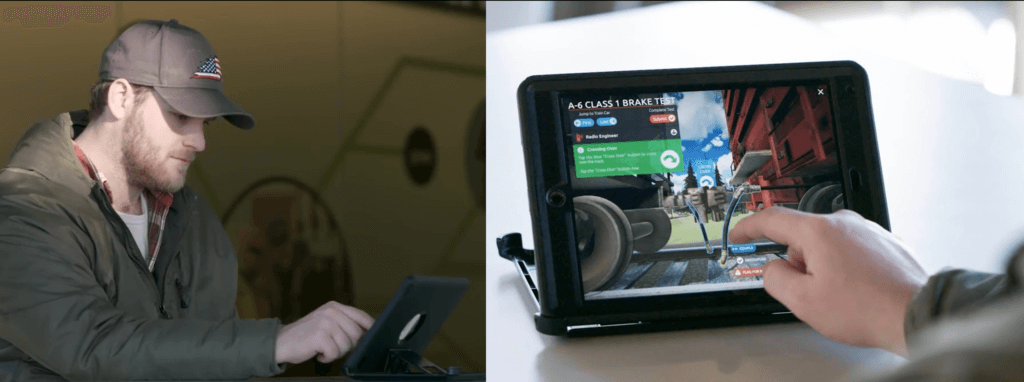
Technology acceleration has touched every industry this past year, the rail industry among them. But this isn’t bad news, as the variety of technologies available are creating more efficient, safer operations, with additional advancements on the horizon, which we’ll touch on below.
The technological shift in the industry has been significant. As Travis Herod, SVP Environmental Health & Safety, Watco puts it, we’re in the midst of an incredible transition:
“I believe we’re in the middle of the third major industrial revolution. We saw major changes in how the world did business when steam power industrialized nations, and again, as the electrical revolution changed the landscape. I believe technology integration will prove to have a similar, significant impact on industry as we learn to leverage and harness the power of emerging technology. And just like the first two revolutions, there will be challenges along with opportunity, we need to be courageous enough to embrace the changes, while ensuring we deploy new technology safely and thoughtfully.”
And these challenges are certainly front and center as we head into year two of the pandemic. Fortunately, railroads were already off and running with advanced technologies before COVID hit, and that was a good place to be when industries all around us slowed to a crawl. Although impacted along with the rest of the world, railroads were already shifting toward automation and precision scheduled railroading (PSR) in the years prior. Change was still necessary, but it meant picking up the pace more than anything, as demonstrated by:
- Positive Train Control (PTC)
- Autonomous inspection technologies
- AI-powered monitoring technologies
- Virtual Simulated Training
Positive Train Control is a fully implemented functionality that was designed to prevent human error – and it often does. But, it doesn’t stop all track-related nor equipment-related derailments and accidents, which is the goal of the future. Doing so will require a renewed commitment to technological innovation and rethinking current regulatory procedures that bog down the process.
Autonomous track inspection technologies offer an exceptional assist to PTC. They offer more thorough inspection, less train delays, and reduces inspector headcount. The future of this technology is found in the lighter system developed last year by Norfolk Southern. Unlike its predecessors, which “are heavy and bulky devices installed on converted freight or passenger rail cars . . . [and] typically require an external power source to operate,” this system will be “powered by a computer inside the electrical locker in the locomotive cab.” It will “complement data gathered from testing involving manned track geometry cars and hi-rail trucks.”
Rail research on key track issues continues as well, with the AAR’s Transportation Technology Center, Inc (TTCI) pursuing projects including infrastructure/weld performance; rail performance and integrity; and bridge testing under heavy axel loads. And then we see artificial intelligence and machine learning capabilities playing an increasing role in car inspections with industrial AI software becoming mainstream.
Autonomous Operations & Enhanced Safety Protocols
Beyond what’s been detailed above, there are also Single Person Crew recommendations currently under review by the FRA. Using Western Australia’s “heavy-haul, long-distance autonomous rail operations” as a case study, they’re seeing improved “safety by reducing risk at level crossings and through its automated responses to speed restrictions and alarms. It also eliminates the need to transport drivers to and from trains mid-journey saving almost 1.5 million kilometres of road travel each year – a safety risk. And it delivers productivity and environmental benefits by using information about the train and rail network topography to calculate and deliver a safe, consistent driving strategy.”
Operating with less staff requires exceptionally trained staff. And keeping workers up-to-speed on these changes as they happen will require equally innovative and fast-paced training. We connected with Mark Vaughn, Assistant General Manager, Iowa Northern Railway Company about this potential:
“The recent rapid acceleration in technology has provided railroads opportunities for training solutions that were not easily or even attainable in the recent past. New simulation technologies have provided employees in various departments the opportunity to train in vastly immersive virtual environments. These technologies provide a platform for the users to develop critical thinking skills with higher rates of knowledge retention than some of the methods previously utilized. These emerging safety and training technologies allow us to create a safer workplace for our employees and a more efficient operation which means better service and dependability to our customers.”
 We’ve been working with other industry leaders to capture railroad training requirements – simulation-based training modules that are immediately available to personnel anytime, anywhere. It’s an exciting time to be partnering with Class 1, short line and commuter rail companies as they upcycle their training protocols to keep pace with these innovations!
We’ve been working with other industry leaders to capture railroad training requirements – simulation-based training modules that are immediately available to personnel anytime, anywhere. It’s an exciting time to be partnering with Class 1, short line and commuter rail companies as they upcycle their training protocols to keep pace with these innovations!
As our CEO Raj Raheja says:
“Any Railroad that does not use simulation is learning with real mistakes. Simulated scenarios allow for typical and atypical Reps & Sets – improving the muscle memory of railroaders through virtual practice reduces errors – saving money, time and fines.”
Looking Toward a Sustainable Tomorrow
All of this ties into a larger trend affecting us all – sustainability and reducing our carbon footprint. With simulated training, workers aren’t required to travel (nor even miss a shift at work) to obtain the very latest operational intel. This is huge and could tie in well with a growing push toward offering battery-electric locomotives and fuel cell-powered locomotives, the first of which “has rolled off the assembly line at CRRC’s factory” in Datong, China.
“The locomotive uses a combination of a hydrogen fuel cell system and a high-power lithium battery,” says Zhao Mingyuan, chief engineer of CRRC Datong Co. Ltd. “Compared with traditional fuel and electric locomotives, hydrogen-fueled hybrid locomotives are not only safer and more environmentally friendly but also quieter, cheaper and easier to maintain.”
With the trains of tomorrow deploying a variety of autonomous operating systems, as well as “different power levels and power modes to cater to multiple applications, such as operating in tunnels and mines,” it won’t only be equipment that’s in need of retrofitting. As these technologies take hold with greater speed and frequency, be sure the human side of your organization is ready to adapt along with them and get Trained Faster, Smarter, and Safer.
Reach out and we can walk you through simulations that will help you do just that!


